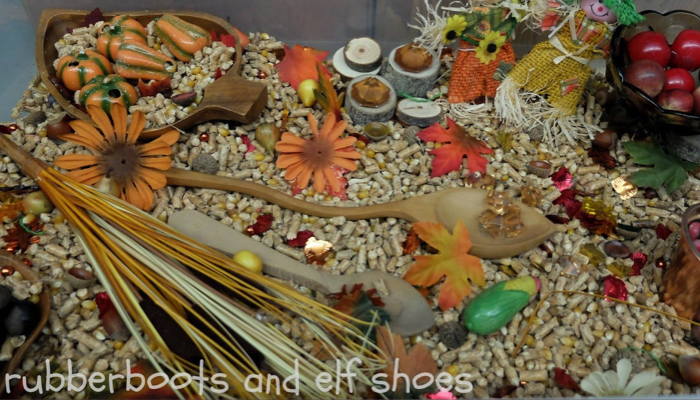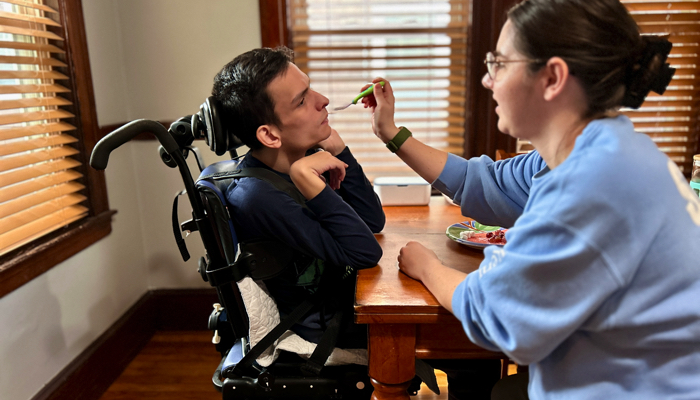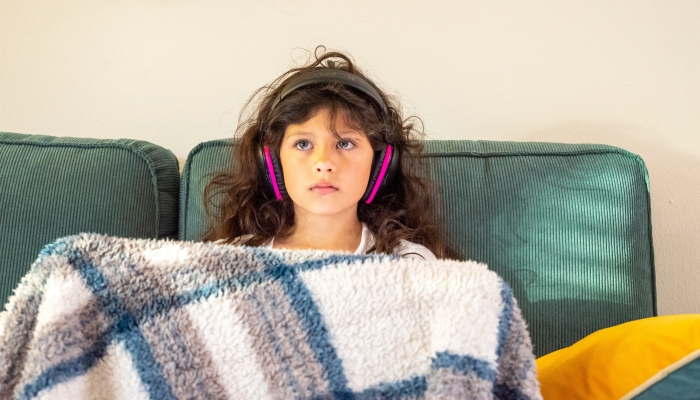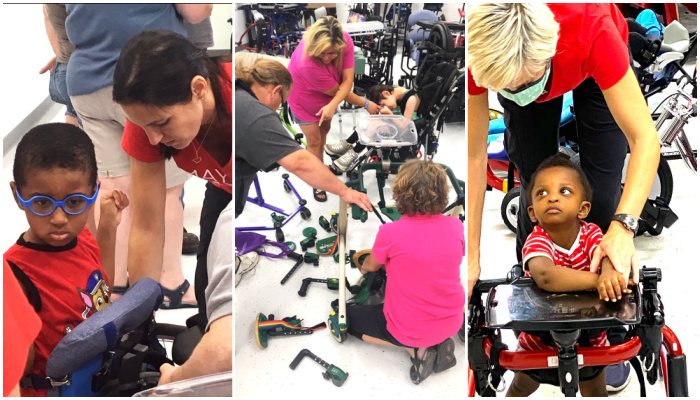5 Tips for a Peaceful Thanksgiving with Your Child with Disabilities

This post may contain affiliate links; please see our terms of use for details.
Thanksgiving can be a joyful yet overwhelming holiday, especially for families with children who have sensory, motor, or dietary needs. With a little preparation and a few practical strategies, you can create a more enjoyable and inclusive celebration. Here are five expert tips to help you and your child have a peaceful Thanksgiving.
Tip 1: Prepare for Behavioral Challenges
Preparing for behavioral challenges can help create a smoother and more enjoyable Thanksgiving for both you and your child. With a bit of planning, structure, and communication, you can set up a supportive environment that reduces stress and helps your child feel more comfortable.
- Use a visual or tactile schedule: If your child benefits from structure, a visual schedule showing the day’s events can help ease transitions and reduce anxiety. Visual schedules can be adapted with tactile elements for kids with visual impairments. These are sometimes called object calendars, and they can be really helpful in helping children anticipate the day’s events.
- Plan for predictable downtime: Designate times for breaks where your child can reset in a quiet space, using noise-canceling headphones or a favorite activity for comfort.
- Communicate expectations with family: Inform relatives in advance if your child may need special accommodations or if certain behaviors are typical for them. This can help minimize misunderstandings.
- Pack a calm-down kit: Calm-down kits can give kids a chance to manage their emotions, especially if they are filled with familiar objects. Include sensory items, fidget toys, or even a favorite snack that your child finds comforting.
- Role-play social interactions: Practicing greetings, taking turns, and saying “thank you” or “goodbye” can make the holiday interactions feel less overwhelming.
Tip 2: Make the Environment Accessible for Kids with Visual Impairments

Creating an accessible environment can help your child with visual impairments feel more comfortable and engaged in the Thanksgiving festivities. Focus on simple adjustments and descriptive cues to enhance their ability to navigate and enjoy the day’s activities independently.
- Adjust the layout: Clear clutter, mark obstacles, and create a spacious path to allow for safe movement around your house or at a family member’s house.
- Use tactile markers: Consider placing a small tactile marker (like textured tape) on commonly used items or surfaces to help with navigation. You could even use communication switches placed around the house to note rooms or navigational cues. Ask your child’s school if you can borrow a couple of switches for the holiday if you don’t have any at home!
- Describe the environment: Use descriptive language to let your child know who is around, what activities are happening, and where they’re sitting in relation to others.
- Offer tactile and auditory engagement: Set up an area with Thanksgiving-themed items your child can explore safely by touch or sound, like autumn leaves, mini pumpkins, or dried corn. Check out this Thanksgiving Concept Box lesson from Paths to Literacy for ideas!
Tip 3: Accommodate Physical Handicaps and Mobility Needs

Making the Thanksgiving setting accessible for children with physical handicaps and mobility needs ensures they can fully participate in the day’s festivities. With thoughtful adjustments to seating, table settings, and accessible spaces, you can create a welcoming environment that supports their comfort and independence.
- Set up an accessible dining area: Ensure the table and seating allow room for your child’s wheelchair, walker, or other mobility devices.
- Provide adaptive seating if needed: If your child needs support for posture or stability, bring adaptive seating to ensure they’re comfortable at the table.
- Choose adaptive table settings: Lightweight, easy-grip utensils or plates with lips can support independent eating. These reusable food guards and EazyHold Grip Assistant Straps are two of our favorite mealtime aids.
- Offer alternative seating options: If your child needs to rest or prefers another position, set up a comfortable, accessible space away from the table where they can relax.
- Bring a portable ramp: Consider purchasing a portable wheelchair ramp if you will be visiting family with a few steps up to their house. We bought this folding wheelchair ramp so we could visit friends over the summer and it made getting our wheelchair into the house so much easier!
Tip 4: Minimize Sensory Overload

Minimizing sensory overload can make Thanksgiving more enjoyable and less overwhelming for children with sensory sensitivities. Be wary of environmental factors like noise and smells and provide calming tools to create a sensory-friendly experience that allows your child to relax and feel comfortable.
- Control noise levels: Thanksgiving gatherings can be loud. Set up a designated quiet space where your child can go to escape noise if needed.
- Minimize strong scents: Reduce overpowering smells from candles, cooking, or perfume to avoid triggering sensitivities.
- Pack sensory-friendly items: Bring noise-canceling headphones, fidget tools, weighted blankets, or any items that help soothe your child.
- Schedule regular breaks: Plan for periodic “sensory breaks” where your child can unwind away from the holiday hustle and bustle.
Tip 5: Manage Dietary Restrictions and Special Feeding Needs

Managing dietary restrictions and special feeding needs can help your child feel included and safe at the Thanksgiving table. By planning for allergies, texture preferences, and safe food options, you can ensure your child enjoys the holiday meal without worry.
- Communicate dietary restrictions early: If others are preparing food, share any allergies or texture sensitivities with them to avoid cross-contamination or other issues. It is definitely possible to plan a holiday event for kids with food allergies!
- Bring preferred foods: To prevent surprises, bring some familiar or safe foods that your child enjoys and can tolerate.
- Adapt textures and portions: For children who require pureed or soft foods, bring pre-prepared dishes that can be easily served. If your child can only handle specific textures, adapt common holiday foods to suit their preferences.
- Have safe treats ready: Thanksgiving desserts can be challenging for children with allergies. Prepare or bring safe, allergy-free treats your child can enjoy along with everyone else. Our son loves marshmallows, so we usually bring along some gourmet holiday-themed marshmallows to share with everyone!
Bonus Tip: Set Realistic Expectations and Be Flexible
Setting realistic expectations and remaining flexible can make Thanksgiving more enjoyable for everyone involved. If you focus on the positive and embrace the small wins while letting go of the idea of perfection, you can create a memorable holiday with much less pressure.
- Talk through the plan: Go over the day’s plan and be prepared to adjust it based on how your child is feeling.
- Focus on small, positive moments: Thanksgiving may not go perfectly, and that’s okay. Aim to enjoy the moments where your child is comfortable and happy.
- Be prepared to leave early if needed: Sometimes, it may be best to end the day early to prevent overwhelm.
- Stay open to change: If your child struggles with new foods, noise, or activities, consider modifying your plans to suit their needs.
Creating a peaceful Thanksgiving with your child with disabilities is about balancing tradition with flexibility. By planning for sensory needs, preparing meals with dietary restrictions in mind, and equipping yourself with tools and strategies, you can make the holiday enjoyable for everyone. Remember, it’s okay to let go of expectations and simply focus on making the day a positive experience for your family!

Related Posts

Special Needs
5 Spring Cleaning Tips for Families of Children with Disabilities
Spring cleaning is an opportunity to create a more accessible, organized, and supportive space for your child with disabilities. Declutter, deep clean, and refresh!

Visual Impairment
The Gift of Understanding: How a Young Child Helps His Blind Father Navigate Life
When a parent is blind, it’s natural for people to wonder how their sighted child will adapt. Will they struggle to understand their parent’s needs? Will they feel burdened by...

Assistive Technology, Support
May We Help: Engineering Independence for People with Disabilities
May We Help is dedicated to designing and building custom solutions that help individuals of all ages achieve mobility, access, and independence, all at no cost.